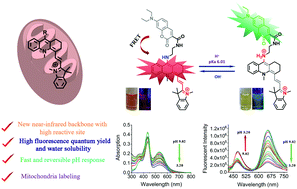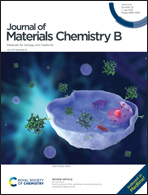A ratiometric near-infrared fluorescent probe based on a novel reactive cyanine platform for mitochondrial pH detection†
Abstract
A near-infrared reactive cyanine platform (probe A) was prepared by condensation of 9-chloro-1,2,3,4-tetrahydro-10-methyl-acridinium iodide with Fisher's aldehyde. A near-infrared fluorescent probe (probe B) was prepared by modifying a reactive chlorine atom of probe A with tert-butyl(2-aminoethyl)carbamate through a substitution reaction. The deprotection of the Boc group of probe B was achieved under an acidic condition, affording an amine-functionalized cyanine dye (probe C). A near-infrared ratiometric fluorescent probe (probe D) for mitochondrial pH detection was synthesized by conjugating a FRET coumarin donor to a FRET cyanine acceptor (probe C) through an amide bond connection. Probe A shows low fluorescence of 2% due to an electron-withdrawing chlorine atom, while probes B–D display high fluorescence quantum yields of 60%, 32%, and 35% in aqueous solutions containing 10% ethanol, respectively. Probes B–D show strong fluorescence with push–pull molecular structures in neutral and basic pH conditions. However, protonation of the probe's second amine at the 9-position under acidic condition disrupts the push–pull feature of the probes, resulting in fluorescence quenching of the new cyanine fluorophores. The probes can selectively stain mitochondria, while probe D was employed to detect pH changes in HeLa cells and Drosophila melanogaster first-instar larvae.



 Please wait while we load your content...
Please wait while we load your content...